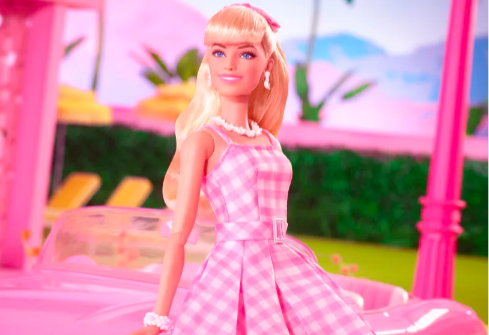Barbie: The Pink Puzzle To Girl Empowerment
- Sarah Odibat

- Feb 9, 2024
- 3 min read
Updated: Jun 10, 2024
Picture this: it's the late 1950s, and amid traditional baby dolls, a revolutionary figure
appears, questioning norms and redefining the narrative of playtime. This original figure is
none other than Barbie, a fashion-forward, career-driven doll that has changed the perception
of women’s empowerment for girls globally.

Barbie was created in 1959 by Ruth Handler, the co-founder of Mattel. It was inspired
by the German Bild Lilli doll, a cartoon character in a famous German magazine, marketed to
adults, mostly men, as a gag gift. Barbie was named after Ruth Handler’s daughter, Barbara,
and eventually Ken was named after Ken, her son.
Unlike toys marketed for young girls at the time, like baby dolls, Barbie wasn’t made
to teach girls to nurture and care for a child. Barbie was created for another purpose: to
inspire the limitless potential in every girl. Barbie rewrote stereotypical gender norms by
pursuing and embracing typically male-dominated careers- from an astronaut to an Olympic
athlete to a surgeon. This not only reinforces the concept that women can thrive and succeed
in any industry, but it also instills in young girls a mindset that their ambitions are limitless,
inspiring them to take risks and pursue male-dominated careers, like STEM. “We have
always known that a small doll can make a big impact. Today we bring power to our purpose,
not only as a global icon, but as an advocate for real social and environmental change.“
(Mattel)
Today, diversity stands as one of the most crucial elements of the concept of Barbie.
Barbie first emerged with a Caucasian, slim body, similar to that of the Lilli doll. Later,
Mattel came out with an African-American doll in 1967, which was a darker skin tone on the
same, original body. As time passed and inclusivity grew, Barbie vision of diversity also
changed.
Nowadays, the Barbie line includes “35 different skin tones, 97 hairstyles, and 9 body types.”
The main purpose of enforcing such a diverse line was so that children could see
themselves in Barbie no matter what physical attributes make them stand out from others. It
ensures that the concept of Barbie can and does apply to everyone- no matter the race, height, weight, body type, skin tone, ethnicity, disability, etc.
In 2023, the Barbie movie came out, featuring Margaret Robbie and Ryan Gosling.
While it illustrated the concept of feminism in a women-run world, it also sparked
discussions about gender equality. Personally, I felt that this movie did not show gender
equality, which is one of the main problems that Barbie addresses. This is shown in the
beginning and at the end of the movie, where the “Kens” are second-class citizens while the
“Barbies” are at the top of the hierarchy. This goes against the morals of gender equality and
feminism- which illustrates that women are not any better or worse than man, and we can be
successful in male-dominated industries as well.
To give you a slice of others’ perspectives, I asked a few of my friends to complete a
survey about their opinion on the impact of Barbie on women’s empowerment. On a specific
question about their opinions on the Barbie movie, one girl said, “I liked the way the Barbie
movie showed that women have a lot more to them than their looks.”
Another girl observed, “I really saw how the roles reversed in the movie were accurate to society nowadays.”
Moreover, I asked the same girls what they think of when they hear the word “women’s
empowerment”. The most common answers I received include: women in STEM, feeling
beautiful and not looked down on, and embracing feminism. These responses show Barbie’s
impact on self-perception and societal values, as well as the common thoughts about
women’s empowerment.
In essence, Barbie is an inspiration in the continuous struggle for gender equality and
empowerment for all. Barbie's ongoing history demonstrates the brand's commitment to
inspire generations of girls to dream big, defy norms, and believe in their own infinite
potential. Barbie's Pink Puzzle continues to expand, leaving a lasting legacy of empowerment
and perseverance.
Martínez, Alonso, et al. “Barbie and Diversity: A Long Journey of Criticism and
Change.” EL PAÍS English, 20 July 2023, english.elpais.com/culture/2023-07-
20/barbie-and-diversity-a-long-journey-of-criticisms-and-change.html.
Lord, M. G. “Barbie | History, Dolls, and Facts.” Encyclopedia Britannica, 5 Feb.
Martínez, Alonso, et al. “Barbie and Diversity: A Long Journey of Criticism and
Change.” EL PAÍS English, 20 July 2023, english.elpais.com/culture/2023-07-
20/barbie-and-diversity-a-long-journey-of-criticisms-and-change.html.
Sarah Odibat, 16, USA




Comments